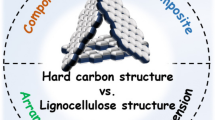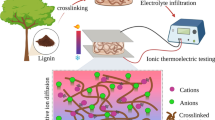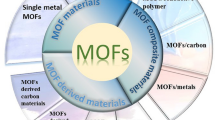Abstract
Lignin has gained extensive attention as an ideal carbon precursor due to its abundance and high carbon content. However, the agglomeration of lignin and additional corrosive and unrecyclable reagents in direct pyrolysis still limit the development of lignin-based porous carbons. Herein, a facile and eco-friendly strategy was proposed to fabricate hierarchical porous lignin/cellulose-based carbon materials (LCs). In the process, cellulose nanofibrils acted as the skeleton of the bio-aerogels, which supported lignin and benefit the preparation of the LCs. Moreover, the specific surface area and the graphitization degree of LCs can be regulated by varying the cellulose content. Without activation, the bio-based carbon material (LC30) had a high specific surface area of 1770 m2 g−1, which displayed high specific capacitance of 216.2 F g−1 at the current density of 0.5 A g−1. The supercapacitor based on LC30 also showed outstanding energy density of 12.3 Wh kg−1 at the power density of 50 W kg−1. The sustainable raw material, simple and harmless preparation process, and remarkable electrochemical performance enable LC30, a promising supercapacitor electrode for energy storage.








Similar content being viewed by others
Data availability
The authors declare that the data supporting the findings of this study are available within the paper and its Supplementary Information files.
References
Yun S, Zhang Y, Xu Q, Liu J, Qin Y (2019) Recent advance in new-generation integrated devices for energy harvesting and storage. Nano Energy 60:600–619. https://doi.org/10.1016/j.nanoen.2019.03.074
Wang A, Sun K, Xu R, Sun Y, Jiang J (2021) Cleanly synthesizing rotten potato-based activated carbon for supercapacitor by self-catalytic activation. J Clean Prod 283:125385. https://doi.org/10.1016/j.jclepro.2020.125385
Hu X, Wu H, Liu S, Gong S, Du Y, Li X, Lu X, Qu J (2022) Fabrication of organic shape-stabilized phase change material and its energy storage applications. Eng Sci 17:1–27. https://doi.org/10.30919/es8d474
Hou C, Yang W, Kimura H, Xie X, Zhang X, Sun X, Yu Z, Yang X, Zhang Y, Wang B, Xu BB, Sridhar D, Algadi H, Guo Z, Du W (2023) Boosted lithium storage performance by local build-in electric field derived by oxygen vacancies in 3D holey N-doped carbon structure decorated with molybdenum dioxide. J Mater Sci Technol 142:185–195. https://doi.org/10.1016/j.jmst.2022.10.007
Ma Y, Hou C, Kimura H, Xie X, Jiang H, Sun X, Yang X, Zhang Y, Du W (2023) Recent advances in the application of carbon-based electrode materials for high-performance zinc ion capacitors: a mini review. Adv Compos Hybrid Mater 6:59. https://doi.org/10.1007/s42114-023-00636-1
Muzaffar A, Ahamed MB, Deshmukh K, Thirumalai J (2019) A review on recent advances in hybrid supercapacitors: design, fabrication and applications. Renew Sust Energ Rev 101:123–145. https://doi.org/10.1016/j.rser.2018.10.026
Largeot C, Portet C, Chmiola J, Taberna P-L, Gogotsi Y, Simon P (2008) Relation between the ion size and pore size for an electric double-layer capacitor. J Am Chem Soc 130:2730–2731. https://doi.org/10.1021/ja7106178
Mukhopadhyay A, Jiao Y, Katahira R, Ciesielski PN, Orcid MH, Zhu H (2017) Heavy metal-free tannin from bark for sustainable energy storage. Nano Lett 17:7897–7907. https://doi.org/10.1021/acs.nanolett.7b04242
Lin Z, Guan Z, Huang Z (2013) New bacterial cellulose/polyaniline nanocomposite film with one conductive side through constrained interfacial polymerization. Ind Eng Chem Res 52:2869–2874. https://doi.org/10.1021/ie303297b
Dujearic-Stephane K, Gupta M, Kumar A, Sharma V, Pandit S, Bocchetta P, Kumar Y (2021) The effect of modifications of activated carbon materials on the capacitive performance: surface, microstructure, and wettability. J Compos Sci 5:66. https://doi.org/10.3390/jcs5030066
Wu Q, Zhang G, Gao M, Huang L, Li L, Liu S, Xie C, Zhang Y, Yu S (2019) N-doped porous carbon from different nitrogen sources for highperformance supercapacitors and CO2 adsorption. J Alloy Compd 786:826–838. https://doi.org/10.1016/j.jallcom.2019.02.052
Lin Y, Zhang Q, Deng Y, Shen K, Xu K, Yu Y, Wang S, Fang G (2021) Fabricating nanodiamonds from biomass by direct laser writing under ambient conditions. ACS Sustainable Chem Eng 9:3112–3123. https://doi.org/10.1021/acssuschemeng.0c07607
Lin Y, Zhang Q, Deng Y, Wu Q, Ye XP, Wang S, Fang G (2021) Fabricating graphene and nanodiamonds from lignin by femtosecond laser irradiation. ACS Omega 6:33995–34002. https://doi.org/10.1021/acsomega.1c05328
Jeon JW, Zhang L, Lutkenhaus JL, Laskar DD, Lemmon JP, Choi D, Nandasiri MI, Hashmi A, Xu J, Motkuri RK, Fernandez CA, Liu J, Tucker MP, McGrail PB, Yang B, Nune SK (2015) Controlling porosity in lignin-derived nanoporous carbon for supercapacitor applications. Chemsuschem 8:428–432. https://doi.org/10.1002/cssc.201402621
Zhang Y, Yu B, Zhang J, Ding X, Zeng J, Chen M, Wang C (2018) Design and preparation of lignin-based hierarchical porous carbon microspheres by high efficient activation for electric double layer capacitors. ChemElectroChem 5:2142–2149. https://doi.org/10.1002/celc.201800488
Wu Y, Cao J-P, Zhao X-Y, Zhuang Q-Q, Zhou Z, Huang Y, Wei X-Y (2020) High-performance electrode material for electric double-layer capacitor based on hydrothermal pretreatment of lignin by ZnCl2. Appl Surf Sci 508:144536. https://doi.org/10.1016/j.apsusc.2019.144536
Saha D, Li Y, Bi Z, Chen J, Keum JK, Hensley DK, Grappe HA, Meyer HM, Dai S, Paranthaman MP, Naskar AK (2014) Studies on supercapacitor electrode material from activated lignin-derived mesoporous carbon. Langmuir 30:900–910. https://doi.org/10.1021/la404112m
Chen Y, Yang S, Fan D, Li G, Wang S (2019) Dual-enhanced hydrophobic and mechanical properties of long-range 3D anisotropic binary-composite nanocellulose foams via bidirectional gradient freezing. ACS Sustainable Chem Eng 7:12878–12886. https://doi.org/10.1021/acssuschemeng.9b01806
Liu W, Yao Y, Fu O, Jiang S, Fang Y, Weia Y, Lu X (2017) Lignin-derived carbon nanosheets for high-capacitance supercapacitors. RSC Adv 7:48537. https://doi.org/10.1039/c7ra08531a
Meng Y, Young TM, Liu P, Contescu CI, Huang B, Wang S (2015) Ultralight carbon aerogel from nanocellulose as a highly selective oil absorption material. Cellulose 22:435–447. https://doi.org/10.1007/s10570-014-0519-5
Sun N, Wang Z, Wang Z, Jiang D, Dai Y, Ma X, Guo Z, Chen Y, Sun L, Lu W, Liu Y (2023) Development and characterization of self-healing cellulose nanofiber reinforced polyurea composite materials based on multiple dynamic interactions. Cellulose 30:223–234. https://doi.org/10.1007/s10570-022-04899-7
Fan G, Wang Z, Ren H, Liu Y, Fan R (2021) Dielectric dispersion of copper/rutile cermets: dielectric resonance, relaxation, and plasma oscillation. Scripta Mater 190:1–6. https://doi.org/10.1016/j.scriptamat.2020.08.027
Fan G, Wang Z, Sun K, Liu Y, Fan R (2021) Doped ceramics of indium oxides for negative permittivity materials in MHz-kHz frequency regions. J Mater Sci Technol 61:125–131. https://doi.org/10.1016/j.jmst.2020.06.013
Xie P, Zhang Z, Liu K, Qian L, Dang F, Liu Y, Fan R, Wang X, Dou S (2017) C/SiO2 meta-composite: overcoming the λ/a relationship limitation in metamaterials. Carbon 125:1–8. https://doi.org/10.1016/j.carbon.2017.09.021
Cai T, Kuang L, Wang C, Jin C, Wang Z, Sun Q (2019) Cellulose as an adhesive for the synthesis of carbon aerogel with a 3D hierarchical network structure for capacitive energy storage. ChemElectroChem 6:2586–2594. https://doi.org/10.1002/celc.201900544
Chen Z, Zhuo H, Hu Y, Lai H, Liu L, Zhong L, Peng X (2020) Wood-derived lightweight and elastic carbon aerogel for pressure sensing and energy storage. Adv Funct Mater 30:1910292. https://doi.org/10.1002/adfm.201910292
Chen Y, Yu Z, Han Y, Yang S, Fan D, Li G, Wang S (2020) Combination of water-soluble chemical grafting and gradient freezing to fabricate elasticity-enhanced and anisotropic nanocellulose aerogels. Appl Nanosci 10:411–419. https://doi.org/10.1007/s13204-019-01162-7
Wang L, Ago M, Borghei M, Ishaq A, Papageorgiou AC, Lundahl M, Rojas OJ (2019) Conductive carbon microfibers derived from wet-spun lignin/nanocellulose hydrogels. ACS Sustainable Chem Eng 7:6013–6022. https://doi.org/10.1021/acssuschemeng.8b06081
Huang X, Yin H, Zhang H, Mei N, Mu L (2022) Pyrolysis characteristics, gas products, volatiles, and thermo-kinetics of industrial lignin via TG/DTG-FTIR/MS and in-situ Py-PI-TOF/MS. Energy 259:123062. https://doi.org/10.1016/j.energy.2022.125062
Liu F, Wang Q, Zhai G, Xiang H, Zhou J, Jia C, Zhu L, Wu Q, Zhu M (2022) Continuously processing waste lignin into high-value carbon nanotube fibers. Nat Commun 13:5755. https://doi.org/10.1038/s41467-022-33496-2
Wang Q, Xia T, Jia X, Zhao J, Li Q, Ao C, Deng X, Zhang X, Zhang W, Lu C (2020) Honeycomb-structured carbon aerogels from nanocellulose and skin secretion of Andrias davidianus for highly compressible binder-free supercapacitors. Carbohyd Polym 245:116554. https://doi.org/10.1016/j.carbpol.2020.116554
Hilbers TJ, Wang Z, Pecha B, Westerhof RJM, Kersten SRA, Pelaez-Samaniego MR, Garcia-Perez M (2015) Cellulose-lignin interactions during slow and fast pyrolysis. J Anal Appl Pyrol 114:197–207. https://doi.org/10.1016/j.jaap.2015.05.020
Ma C, Li Z, Li J, Fan Q, Wu L, Shi J, Song Y (2018) Lignin-based hierarchical porous carbon nanofiber films with superior performance in supercapacitors. Appl Surf Sci 456:568–576. https://doi.org/10.1016/j.apsusc.2018.06.189
Pang J, Zhang W, Zhang H, Zhang J, Zhang H, Cao G, Han M, Yang Y (2018) Sustainable nitrogen-containing hierarchical porous carbon spheres derived from sodium lignosulfonate for high-performance supercapacitors. Carbon 132:280–293. https://doi.org/10.1016/j.carbon.2018.02.077
Zhang F, Liu H, Wu Z, Zhang J, Cui E, Yue L, Hou G (2021) Polyacrylamide gel-derived nitrogen-doped carbon foam yields high performance in supercapacitor electrodes. ACS Appl Mater Interfaces 4:6719–6729. https://doi.org/10.1021/acsaem.1c00777
Sagues WJ, Jain A, Brown D, Aggarwal S, Suarez A, Kollman M, Parka S, Argyropoulos DS (2019) Are lignin-derived carbon fibers graphitic enough? Green Chem 21:4253–4265. https://doi.org/10.1039/C9GC01806A
Zhou S, Brown RC, Bai X (2015) The use of calcium hydroxide pretreatment to overcome agglomeration of technical lignin during fast pyrolysis. Green Chem 17:4748–4759. https://doi.org/10.1039/c5gc01611h
Wang D, Fan W, Yuan S, Liu T (2019) Improving hierarchical porous structure of carbon aerogels for more efficient ion transport for supercapacitors with commercial level mass loading. Electrochim Acta 323:134811. https://doi.org/10.1016/j.electacta.2019.134811
Zhang T, Lang J, Liu L, Liu L, Li H, Gu Y, Yan X, Ding X (2017) Effect of carboxylic acid groups on the supercapacitive performance of functional carbon frameworks derived from bacterial cellulose. Chin Chem Lett 12:2212–2218. https://doi.org/10.1016/j.cclet.2017.08.013
Li F, Wu N, Kimura H, Wang Y, Xu BB, Wang D, Li Y, Algadi H, Guo Z, Du W, Hou C (2023) Initiating binary metal oxides microcubes electromagnetic wave absorber toward ultrabroad absorption bandwidth through interfacial and defects modulation. Nano-Micro Lett 15:220. https://doi.org/10.1007/s40820-023-01197-0
Li F, Li Q, Kimura H, Xie X, Zhang X, Wu N, Sun X, Xu BB, Algadi H, Pashameah RA, Alanazi AK, Alzahrani E, Li H, Du W, Guo Z, Hou C (2023) Morphology controllable urchin-shaped bimetallic nickel-cobalt oxide/carbon composites with enhanced electromagnetic wave absorption performance. J Mater Sci Technol Q48:250–259. https://doi.org/10.1016/j.jmst.2022.12.003
Lei E, Gan W, Sun J, Wu Z, Ma C, Li W, Liu S (2021) High-performance supercapacitor device with ultrathick electrodes fabricated from all-cellulose-based carbon aerogel. Energy Fuels 35:8295–8302. https://doi.org/10.1021/acs.energyfuels.0c04092
Cychosz KA, Guillet-Nicolas R, García-Martínez J, Thommes M (2017) Recent advances in the textural characterization of hierarchically structured nanoporous materials. Chem Soc Rev 46:389–414. https://doi.org/10.1039/c6cs00391e
Mi B, Wang J, Xiang H, Liang F, Yang J, Feng Z, Zhang T, Hu W, Liu X, Liu Z, Fei B (2019) Nitrogen self-doped activated carbons derived from bamboo shoots as adsorbent for methylene blue adsorption. Molecules 24:3012. https://doi.org/10.3390/molecules24163012
Tang Q, Chen X, Zhou D, Liu C (2021) Biomass-derived hierarchical porous carbon/silicon carbide composite for electrochemical supercapacitor. Colloids Surf A 620:126567. https://doi.org/10.1016/j.colsurfa.2021.126567
Zhao Y, Chen P, Tao S, Zu X, Li S, Qiao L (2020) Nitrogen/oxygen co-doped carbon nanofoam derived from bamboo fungi for high-performance supercapacitors. J Power Sources 479:229935. https://doi.org/10.1016/j.jpowsour.2020.228835
Li C, Zhang X, Lv Z, Wang K, Sun X, Chen X, Ma Y (2021) Scalable combustion synthesis of graphene-welded activated carbon for high-performance supercapacitors. Chem Eng J 414:128781. https://doi.org/10.1016/j.cej.2021.128781
Yang H, Sang M, Li G, Zuo D, Xu J, Zhang H (2022) Stretchable, self-healable, conductive and adhesive gel polymer electrolytes based on a deep eutectic solvent for all-climate flexible electrical double-layer capacitors. J Energy Storage 45:103766. https://doi.org/10.1016/j.est.2021.103766
Zhang Y, Liu L, Zhang P, Wang J, Xu M, Deng Q, Zeng Z, Deng S (2019) Ultra-high surface area and nitrogen-rich porous carbons prepared by a lowtemperature activation method with superior gas selective adsorption and outstanding supercapacitance performance. Chem Eng J 355:309–319. https://doi.org/10.1016/j.cej.2018.08.169
Huang G, Liu Y, Chen H, Xing B, Li Y, Yao Y, Jia J, Liu Q, Zhang C (2021) A novel grafting-template method to prepare three-dimensional hierarchical porous carbon with high surface area and electrical conductivity for superior-performance supercapacitors. J Power Sources 482:228922. https://doi.org/10.1016/j.jpowsour.2020.228922
Li P, Yang C, Wu C, Wei Y, Jiang B, Jin Y, Wu W (2022) Bio-based carbon materials for high-performance supercapacitors. Nanomaterials 12:2931. https://doi.org/10.3390/nano12172931
Gong Y, Li D, Luo C, Fu Q, Pan C (2017) Highly porous graphitic biomass carbon as advanced electrode materials for supercapacitors. Green Chem 19:4132–4140. https://doi.org/10.1039/c7gc01681f
Mao S, Wen Z, Bo Z, Chang J, Huang X, Chen J (2014) Hierarchical nanohybrids with porous CNT-networks decorated crumpled graphene balls for supercapacitors. ACS Appl Mater Interfaces 6:9881–9889. https://doi.org/10.1021/am502604u
Song P, He X, Shen X, Sun Y, Li Z, Yuan A, Zhai L, Zhang D (2019) Dissolution-assistant all-in-one synthesis of N and S dual-doped porous carbon for high-performance supercapacitors. Adv Powder Technol 30:2211–2217. https://doi.org/10.1016/j.apt.2019.07.001
Funding
This work was financially supported by the Natural Science Foundation of Jiangsu Province (Grant No. BK20211025), the National Natural Science Foundation of China for Youth (Grant No. 32301681), the Foundation of Jiangsu Key Lab of Biomass Energy and Materials (Grant No. JSBEM-S-202317), and the National Postdoctoral Researcher Program of China (Grant No. GZB20230847).
Author information
Authors and Affiliations
Contributions
Yan Lin: conceptualization, methodology, investigation, writing—original draft, and review and editing. Chen Huang: supervision and writing—review and editing. Caoxing Huang: writing—review and editing. Yongjun Deng: writing—review and editing. Xiuxiu Zou: investigation. Wencan Ma: investigation. Guigan Fang: supervision and writing—review and editing. Arthur J. Ragauskas: writing—review and editing.
Corresponding authors
Ethics declarations
Conflict of interest
The authors declare no competing interests.
Additional information
Publisher's Note
Springer Nature remains neutral with regard to jurisdictional claims in published maps and institutional affiliations.
Supplementary Information
Below is the link to the electronic supplementary material.
Rights and permissions
Springer Nature or its licensor (e.g. a society or other partner) holds exclusive rights to this article under a publishing agreement with the author(s) or other rightsholder(s); author self-archiving of the accepted manuscript version of this article is solely governed by the terms of such publishing agreement and applicable law.
About this article
Cite this article
Lin, Y., Huang, C., Huang, C. et al. Cellulose regulated lignin/cellulose-based carbon materials with hierarchical porous structure for energy storage. Adv Compos Hybrid Mater 7, 51 (2024). https://doi.org/10.1007/s42114-024-00850-5
Received:
Revised:
Accepted:
Published:
DOI: https://doi.org/10.1007/s42114-024-00850-5




